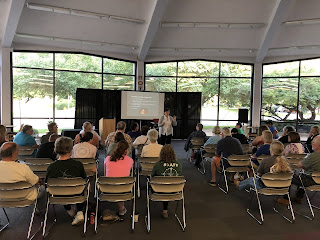 |
| Troweling in my unit. |
Hello, my name is Melanie, and I am a Western student participating in this summer’s Fort St. Joseph archaeological program. The first lecture of this year’s field school hosted Dr. Kathryn Ehrhardt as our guest speaker. Dr. Ehrhardt has worked at various 17th and 18th century sites across the northeastern United States. She specializes in studying copper and copper alloys, and in her lecture, that is what she focused on. She discussed the differences between Native American and European copper, explained some of the best tools and techniques used to analyze a copper artifact, and what archaeologists, as well as the community, can learn from this information. Her lecture tied in perfectly with this field season’s theme of technology.
There is a vast difference in quality comparing Native American copper to European copper. The Natives of the 17th and 18th centuries worked copper that was 99% pure, while the Europeans smelted their copper and added in various metals such as tin, zinc, and brass. This mixture of metals is called copper alloy, and during the colonial era, it was used to make a multitude of products of every-day quality. Native Americans of the northeastern section of the United States had a plethora of mines around Lake Superior from which they could extract copper. In fact, this area has the largest deposit of pure copper in the world! It is unclear whether or not the Natives hot-worked their copper, but it is certain that they did not add in other metals at all.
Around the 17th and 18th centuries, groups of Native Americans began trading with Europeans, especially the French. The Europeans desired furs, while the Natives received items such as guns and kettles made of brass or copper alloy. While they did occasionally use these tools as they were intended, it was more common for the Natives to reinvent these items and incorporate them into their own culture. They stripped the metal plating from the guns and dismantled the kettles to use the sheet metal for their own purposes. These reimagined items were often jewelry or other types of clothing ornamentation. As Dr. Ehrhardt explained, the Natives likely viewed copper as a precious metal, thus they were willing to trade many furs for copper items.
Despite being almost completely pure, there were very few scholars who were interested in the study of Native American copper before Dr. Ehrhardt began her research. This was in part because of lack of interest in the subject, as well as lack of proper equipment to analyze copper artifacts. Dr. Ehrhardt helped usher in new techniques for archaeologists, and with that, a booming interest in the study of copper and copper alloys.
After consulting with several scientists and convincing them of the importance of researching 17th and 18th century copper, Dr. Ehrhardt and several other scholars were able to find pre-existing scientific technology able to analyze copper artifacts. The main technologies and methods that are still used today include: Instrumental Neutron Activation Analysis (INAA), Laser Ablation-Inductively Coupled Plasma Mass Spectrometry (LA-ICP-MS), Particle-Induced-X-Ray Emission (PIXE), Portable X-Ray Fluorescence Spectrometry (PXRF), metallography (the study of the structure and properties of metal), and microscopy (the use of a microscope). Each process has its own pros and cons, and their use should be evaluated based upon the artifact in question as well as the situation of the archaeological excavation.
From the analysis of various copper artifacts, it is possible to track the source mine that the copper was pulled from, as long as there is a sample of that mine’s copper on file. This is a very important piece of information for archaeologists, because from this it is possible to determine who was trading with whom at what time. As we can determine from the fur trade, the exchanging of goods can impact a culture drastically. Archaeologists are now able to acquire this information regularly thanks to new technologies and scientific methods.
The things we can all learn by working together to analyze the past are incredible. Communicating with various scientists, communities, and organizations gives archaeologists a larger perspective. It is likely that if archaeologists do not have the solution to a problem, there is someone out there that has the answer. When we communicate and focus on our shared interest of the past, learning from each other and incorporating new methods and technologies into our research, there is very little that we cannot overcome.

No comments:
Post a Comment